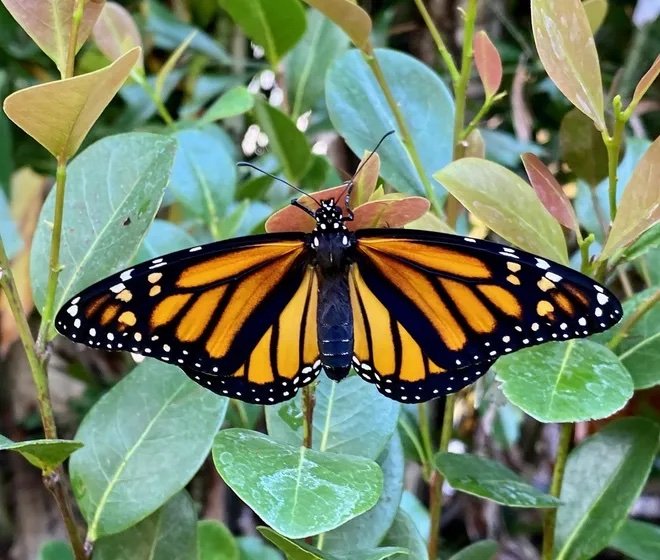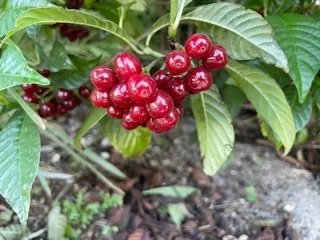Green gardening in Palm Beach: Try these alternatives to planting banned ficus
The red flowers of the Florida fire bush add color and interest to a hedge while attracting numerous pollinators.
January 14, 2023
With so much construction going on throughout South Florida and Palm Beach, new hedges are inevitably being planted everywhere. Ficus (Ficus benjamina) has been banned due to the whitefly infestation and landscapers are now recommending clusia as a replacement. This is absolutely the wrong choice.
Privacy hedges are fine and with the proximity of homes, it’s nice to have a sense of enclosure and privateness.
In the early 1900s and for over a century, exotic, fast-growing species were brought to Palm Beach because many of them do so well here. Coming from different parts of the world, they have no natural predators.
Since the 1950s, the fast-growing Ficus benjamina, native to Asia and Australia, was zealously planted as an almost instant hedge. These hedges were initially non invasive, but all plants require specific pollinators and since their pollinator wasn’t here, they produced no viable seed. All that changed in the 1980s when the wasp necessary for the ficus’ pollination appeared. Once this species was able to produce seed, it quickly became invasive.
Its rapidly growing roots invade gardens, grow under and ultimately lift sidewalks, patios and driveways, and the trees are high-risk during storms as they readily succumb to gale-force winds.
A whitefly is shown on a ficus leaf on Brazilian Avenue in 2018. The whitefly was able to invade and infest these plants with no deterrents.
Palm Beach Daily News
Our overabundance of Ficus benjamina hedges created a monoculture on Palm Beach and nature, which abhors a monoculture and thrives on diversity, responded with a natural control agent.
The whitefly predator was able to invade and infest these plants with no deterrents. Had we been paying attention, we would have applauded the arrival of this natural control for what had become a dangerous invasive species. Instead, Florida’s Agricultural Extension Service advocated the use of sprays and soil drenches with systemic neonicotinoids, including imidacloprid, which kill not only whitefly but all our pollinators.
Since the 1980s, these chemicals have leached into our soils and aquifers, polluting our drinking water and adversely affecting birds, fish, manatees and aquatic life throughout our estuaries. Once neonicotinoids have contaminated water sources, traditional chlorination treatment cannot remove them from our drinking water. They also contaminate our food; residues have been found in 86% of U.S. honey and are omnipresent in fruits such as apples, cherries and strawberries.
And understand that these neonicotinoids are in our fruits and vegetables, so they cannot be washed or peeled off. They are also proven carcinogens, linked to neurological disorders from Parkinson’s, Alzheimer’s and autism to numerous forms of leukemia.
Perhaps the worst part of this is that ultimately the use of neonicotinoids is for naught. Currently up to 100% of conventional corn seeds and 50-75% of conventional soybean seeds are pretreated with a neonicotinoid (usually glyphosate) prior to planting, to protect them from insect damage.
We are now learning that these treatments provide little to no economic benefits to growers. They actually reduce crop yields as they damage the health of the soil by killing all essential micronutrients. Our crops are contaminated with carcinogenic chemicals and their nutritional content is greatly diminished, while our essential pollinators are killed, further reducing crop yield. It’s basically insane.
Native vs. non-native clusia
But I digress. I was talking about hedges.
Try Clusia roses instead of Clusia flukiness to replace a hedge made up of Ficus Benjamina. ME GHAN MCCARTHY/palmbeachdailynew.com
As Ficus benjamina may no longer be planted in Palm Beach, landscapers are now often recommending the clusia species, which many insist are native.
The autograph tree (Clusia rosea) is indeed a lovely salt- and drought-tolerant native, growing to 30 feet with thick, leathery, paddle-shaped leaves, large pinkish white flowers, and round, orange-green fruits. Its dense foliage provides excellent habitat for birds and wildlife, and it has the rare ability to produce viable seed without pollination, a condition known as agamospermy. It is nicknamed the autograph tree because if you scratch a word into the leaf of the tree, it will remain there indefinitely.
Aside from its attractive flowers and foliage, it is valuable for its resistance to hurricane-force winds. This is a great native plant, but sadly, this is not what is being planted as hedge material in South Florida. Instead the non-native Clusia fluminensis is being touted by the nursery trade as the next best thing after ficus, which, of course, wasn’t such a great thing after all.
Clusea fluminensis is one of numerous species of clusia native to Brazil. While it can make a quick-growing hedge, it will reach an ultimate height of 30 feet, so it must be constantly trimmed.
Dwarf varieties also are on the market but these don’t actually exist. With its large leaves, Clusia fluminensis does not lend itself to conventional trimming with power shears; this damages the foliage, leaving unsightly glaring edges. Careful, manual pruning is much preferred but is far too time-consuming for the average landscaper. Additionally, this plant is dioecious (male and female parts on separate plants) and needs a pollinator that has not yet arrived here, but it is only a matter of time before one does, providing the potential for another invasive species. Fortunately, the town of Palm Beach has recognized this danger and now uses the slogan “ABC” for new hedges: Anything But Clusia.
The gray-green foliage of the saw palmetto adds interest to a hedge of wild coffee and Simpson’s stopper.
Resist the temptation
I’ve talked about hedges on numerous occasions, but people are still wondering what to plant and landscapers often advise whatever they can easily and cheaply procure. Since clusia can germinate by simply sticking a branch into the ground, it is a quick, efficient and highly profitable choice.
Resist the temptation to use this, and don’t think that hedges must be composed of a single plant material.
A hedge of thatch palms, Simpson’s stopper and wild coffee is boarded by Salvia misella ground cover.
The most beautiful, lush, and maintenance-free hedges are made up of numerous species, and these in turn provide the diversity needed to sustain pollinators, birds and wildlife.
The hedge is composed of gumbo limbo, Florida fire bush, sabal palm, Jamaican caper, wild coffee and Florida privet.
Depending on your location, here are several species from which to choose: In coastal areas, try silver or green buttonwood (Conocarpus erectus); blackbead (Pithecellobium keyense); black ironwood (Krugiodendron ferreum); and sabal palm (Sabal palmetto). All are salt-, wind-, and drought-tolerant.
A Monarch rests on a cocoplum, which can make a nice hedge.
Further inland, try wild coffee (Psychotria nervosa); saw palmetto (Serenoa repens); white indigoberry (Randia aculeata); Bahama strongbark (Bourreria succulenta); marlberry (Ardisia escallonioides); Simpson's stopper (Myrcianthes fragrans); Spanish stopper (Eugenia foetida); Florida boxwood (Schaefferia frutescens); thatch palm (Thrinax radiata); cocoplum (Chrysobalanus icaco); Jamaican caper (Capparis cynophallophora); and cinnamon bark (Canella winterana). There are so many more. I haven’t space to describe each of these but have in the past and will again in future posts.
Native Florida fire bush makes a good hedge mixed with cabal and buccaneer palms, blue plumbago and coco plum in a sunny setting.
Landscapes should not be sterile, manicured hedges surrounding pristine, sterile, manicured lawns. Chemical-free gardens containing an assortment of groundcovers, flowers, shrubs and trees will provide far more beauty and interest and require far less maintenance. Their biodiversity provides habitat, food and shelter necessary for our native pollinators, butterflies, birds, wildlife (and children!) to thrive.
Sabal palms, fishtail palms, wild coffee and Jamaica caper make a dense hedge in deep shade.
The beautiful berries of wild coffee (Psychotria nervosa), which makes a great native hedge plant for sun or shade.
The Florida boxwood also is a candidate to replace a ficus hedge.
Wild cinnamon bark, as seen at Pan’s Garden, is a wonderful, small, slow-growing tree with a dense rounded crown and thick aromatic leaves.












